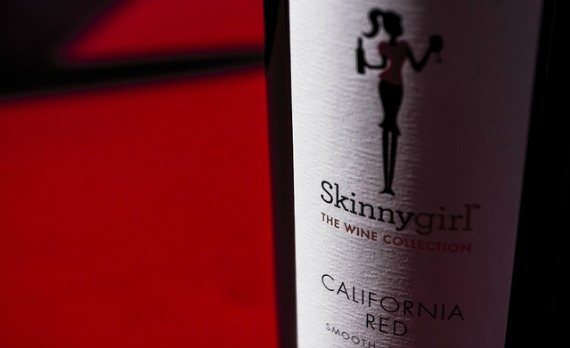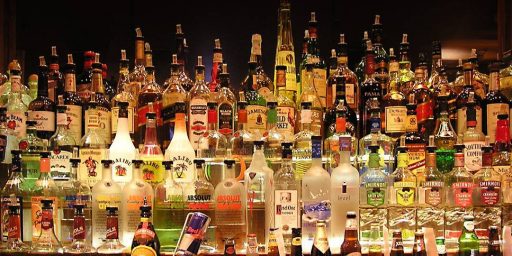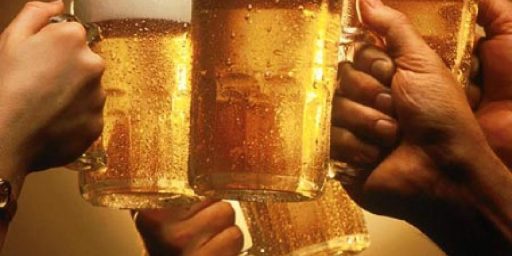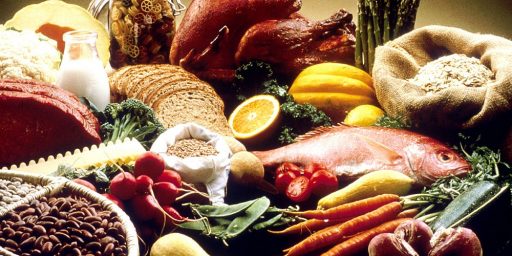Drunkorexia?!
Apparently, some significant number of people are starving themselves to "save calories" for getting drunk.
Apparently, some significant number of people are starving themselves to “save calories” for getting drunk.
The Atlantic (“Road to ‘Drunkorexia’“):
In a culture that’s still obsessed with dieting, the U.S. weight loss industry is worth around $60 billion and growing. In recent years, there’s been an important addition to that market: alcoholic beverage companies. Marketing increasingly plays to consumers’ insecurities by perpetuating the myth that we can — and should — drink without gaining weight.
At the same time, researchers have noted a disturbing trend, especially among college students, that combines the worst of drinking and dieting. They call it “drunkorexia,” which is colloquial for skipping meals or exercising heavily to “save” or burn calories, making room for drinking at night.
[…]
Adam Barry, a professor of health education and behavior at the University of Florida, has compiled the most comprehensive research to-date on drunkorexia, published last spring in the Journal of American College Health.
Barry examined 22,000 college students across 40 universities and found that, even after controlling for race, school year, Greek affiliation and whether a student lived on campus (the authors did not control for whether a respondent played on a sports team), vigorous exercise, and disordered eating uniquely predicted binge drinking. In fact, those who exercised or dieted to lose weight were over 20 percent more likely to have five or more drinks in a single sitting. Students who had vomited or used laxatives in the previous month to shed pounds were 76 percent more likely to binge drink.
Daniella Sieukaran, a clinical psychology graduate student at Simon Fraser University in British Columbia, was already convinced that students were offsetting alcohol calories by extreme dieting. Over the past four years, there have been several studies documenting how common drunkorexia is on college campuses, she said, citing research that as high as 26 percent of young adults use the unhealthy practice to manage their weight. Sieukaran was interested in the longer-term effects of the behavior, and found that, among 227 undergrads at York University in Toronto, students who dieted and drank heavily were more likely to engage in unprotected sex and to require medical treatment for an alcohol overdose.
[…]
Dr. Mark Peluso, director of the Middlebury College health center, points out that drinking on an empty stomach leads to more rapid absorption of alcohol, and higher levels of impairment and intoxication. So every time people purposely do it, they incur increased risks of things like sexual assault and DUIs, and, in the long run, gastritis, ulcer, and malnutrition.
“Alcohol is a desert of nutrients compared to food,” explained Peluso.
As a general rule, college students make a lousy data set for research that seeks to study trends in the wider population. But even ”drunkorexia” were mostly isolated to college campuses, it would be a bizarre and disturbing phenomenon.
Barry’s study is paywalled. Essentially, though, he did a regression analysis of existing research— the Fall 2008 National College Health Assessment—so, this isn’t a case of a professor doing a half-assed study on his own students; this is a massive survey commissioned independently. He and his co-author found that “Physical activity and disordered eating made unique, statistically significant contributions. Moreover, including physical activity and disordered eating behaviors allowed for the correct classification of an additional 431 cases (ie, binge drinkers) over and above the predictive ability of the covariate-only model.” The conclude, “Findings corroborate prior research indicating highly active college students are more likely to binge drink than their nonactive peers, and highlight the potential of a drunkorexia perspective in explaining the counterintuitive alcohol-activity association among college students.”
I’m not sure the findings are counterintuitive. Sure, students who are sufficiently concerned about their health to fit exercise into their schedules should also be smart about their alcohol consumption. But they’re also likely to be far more socially active than their sedentary, out-of-shape peers. To be sure, these studies control for that somewhat, most notably in factoring in participation in Greek organizations; but there’s likely to be a substantial social surplus not captured by that.
The Sieukaran study, which I gather is her dissertation research, doesn’t appear to be published yet. It’s a much less comprehensive study than Barry’s, focusing on “227 17-21-year-old York University students’ dieting and drinking habits at the beginning and end of a four-month period” and “found that of three types of disordered eating — dieting, emotional eating, and eating in response to external stimuli rather than hunger — only dieting was associated with increased alcohol-associated risk behaviours.” This is sufficiently outside my realm of experience that I can’t offhand come up with a plausible explanation.
In terms of the broader phenomenon of “saving up calories to drink,” it doesn’t strike me as inherently problematic unless the person making the calculation is a moron. As I get older, I find it harder to keep the weight off. So, I’m cognizant that a pint of beer or a dram of whisky is adding calories to my diet that I’ll either have to burn off—which my life circumstances make much more difficult than it used to be—or not consume in other forms. But I trade off deserts and snacks, not fruits and vegetables. Indeed, you’d have to skip roughly eight servings of broccoli to make up for a pint of beer, so that’s a pretty stupid trade-off. Even in terms of meats, a single serving of flank steak has fewer calories than a 12 ounce beer.
Frankly, unless you’re an inordinately heavy drinker, alcohol just doesn’t have that many calories. Most spirits are 115 calories a shot, wine is around 90 calories a glass, and most beers are 150 calories for a 12 ounce bottle. Alas, they’re all carbohydrates. And if you’re a fan of sweet cocktails rather than alcohol in its unadulterated form, the totals skyrocket. A Pina Colada has more calories than a Big Mac. And, depending on the size and recipe, a margarita can range anywhere from 168 to 504 calories.
So, don’t be an idiot. Eat a sensible meal. Choose drinks with lower calorie counts. And don’t drink ten of them in a sitting.







This just shows how ignorant our official “research” into eating and dieting can be. These students would do well to dismiss the saving of calories and save carbs instead.
Skip the latte but have nice protein and fat filled steak, especially before going drinking. Slows the absorption and doesn’t pre-stress the liver prior to drenching it in alcohol. So a pina colada is a double or triple whammy.
I had a friend who wanted to lose a couple pounds for her wedding. Since she had an eating disorder in her past, I suggested trying low-carb. She did, was successful but also reported a side effect that she didn’t experience a hangover after drinking while eating low-carb.
lol no, college is not normal life. I remember thinking that if I could get a break I’d sleep for two weeks. When finals were over I really only slept three days.
People in more normal circumstance should just pursue the good old Mediterranean diet, or variations that include the world’s good, healthy, cuisines. Thai chicken-basil is not a bad pairing with a Pinot Noir.
@john personna:
Indeed not. Part of the problem, though, is that college kids tend to eat pizza and burgers, not Thai food. And, especially since women and girls are more prone to this sort of eating disorder, it’s problematic that they–especially at this formative stage–are more likely to be drinking frozen margaritas and other very sweet drinks that straight whiskey, pinot noir, or even a G&T.
I bet it is hard to find a college girl who does not order a few salads every week. That’s ahead of the burger, pizza, and beer boys.
(I really think Thai restaurants cluster around colleges, though “Mongolian Barbecue” is a more frugal college option.)
@john personna:
Salad and a night out drinking are not a good match.
@JKB:
The “salad” is the female version of the flour tortilla [burrito]. It is a vehicle which can contain anything, including 4 ounces of cheese and 3 ounces of nuts. Ham and eggs are not uncommon.
@john personna: Yes! My wife used to order a “salad” that was essentially a meal on a bed of ornamental lettuce. She’d get either filet mignon or smoked salmon, cheese, various vegetables, maybe pasta . . . and some lettuce. I just got a damn steak with potatoes or vegetables.
@James Joyner:
… some of that [seared] ahi and I might go for it myself!
[that one was not college budget]
I’ve been dieting. (32 pounds in 16 weeks, fwck yeah.) I hit my usual set-point, my line of death where my body just says, “That’s it, I’m not losing any more.” Usually I surrender. This time I cut out alcohol aside from a glass of wine per day (or beer equivalent) and blew right through the line of death.
So, yeah, turns out there are calories in eight ounces of whisky. Who knew?
A bit of anecdotal information, but I don’t find myself “saving” calories for evening drinking, but I will find that if I’ve done my eating for the day and I get to the end and have only ingested 1100 or so calories, well, I’ll feel perfectly OK having a drink or two to wind down the end of the day. Though I have to admit, more than once I’ve gone the ice cream sandwich route instead.
Down 65 pounds over the last five months, so it works for me…
I wonder whether part of it is not eating in order to get “buzzed” faster. I’ve noticed that if I haven’t had anything, one Guiness is enough to put me under the table. While if I’ve been noshing, several glasses of wine will have very little effect.
I guess the other question is whether the kids do this every night, or is this behavior saved up for the weekends?
A Guinness pretty much *is* a meal.